Discovering the Prospective of D2C Ecommerce: A Comprehensive Overview for Services
The D2C ecommerce version presents a substantial shift in just how brands involve with customers. It enables companies to bypass standard retail networks, fostering deeper links and potentially raised revenue margins. This strategy is not without its intricacies. Understanding the nuances of D2C ecommerce is vital for brands aiming to flourish. What approaches can they adopt to navigate this advancing landscape successfully? The responses might redefine their company techniques.
Comprehending the D2C Ecommerce Design

Key Conveniences of D2C Ecommerce for Brands
The D2C ecommerce model supplies brand names considerable advantages, specifically pertaining to increased earnings margins. By getting rid of intermediaries, business can keep a bigger share of sales income. Furthermore, this direct relationship with clients cultivates improved brand name loyalty, encouraging repeat purchases and long-term interaction.
Raised Revenue Margins

Enhanced Brand Commitment
Structure on the monetary benefits of D2C ecommerce, boosted brand commitment becomes another crucial benefit for business engaging directly with consumers. By developing a direct connection, brand names can cultivate much deeper partnerships with their customers, gaining insights into preferences and behaviors. This straight interaction permits for even more individualized marketing techniques, which resonate highly with consumers. Additionally, brand names have the opportunity to manage their messaging and customer experience, enhancing brand name values and constructing count on. When consumers really feel a personal link, they are most likely to return, support for the brand name, and join neighborhood involvement. Eventually, enhanced brand name loyalty not only drives repeat purchases yet also grows an enthusiastic customer base, further solidifying a brand name's setting in the marketplace.
Challenges Faced by D2C Brands
D2C brand names come across a number of considerable difficulties that can affect their success. Supply monitoring concerns can result in equip scarcities or excess, complicating procedures and customer fulfillment. Additionally, advertising budget restraints frequently restrict the capacity to efficiently reach and engage target market.
Stock Management Issues
Effective supply monitoring provides a formidable difficulty for numerous brands operating in the direct-to-consumer (D2C) area. These brand names usually face rising and fall need, which can result in overstock or stockouts, ultimately influencing client contentment and profits. Additionally, the lack of innovative inventory monitoring systems can lead to disparities in between real supply degrees and reported data, complicating order satisfaction. The diverse variety of items D2C brands normally use also makes complex supply management, as variations in sizes, shades, and designs call for even more meticulous oversight. Moreover, numerous D2C services might have a hard time with minimal warehousing capabilities, leading to ineffective use room and sources. Efficient stock administration stays an essential obstacle for D2C brands intending for sustainable development and functional effectiveness.
Marketing Spending Plan Constraints
Steering advertising and marketing spending plan restraints is a considerable difficulty for several direct-to-consumer (D2C) brands. Limited financial resources frequently limit these companies' ability to buy comprehensive advertising techniques, causing reduced exposure in an affordable market. D2C brand names regularly come to grips with the requirement to make the most of return on investment (ROI) while targeting details target markets effectively. This challenge is aggravated by rising costs in electronic advertising and marketing and the necessity to allocate funds across multiple networks, consisting of social media, internet search engine, and e-mail advertising. As a result, numerous D2C brand names must introduce cost-effective advertising options, leveraging organic development approaches and influencer collaborations. Ultimately, efficiently maneuvering these budget constraints is essential for maintaining development and achieving long-lasting productivity in the progressing ecommerce landscape.
Strategies for Building a Successful D2C Ecommerce Organization
As customers progressively look for straight connections with brand names, developing an effective D2C ecommerce organization requires a strategic approach that prioritizes consumer involvement and depend on. One effective strategy is to develop engaging brand name narratives that reverberate with target audiences, cultivating emotional links. Making use of social networks systems can improve presence and help with two-way communication, permitting brand names to involve directly with customers.Moreover, customized experiences through tailored advertising and marketing efforts can greatly boost client retention and commitment. Applying commitment programs and offering special deals can better incentivize repeat purchases.Streamlining the purchasing procedure is important, guaranteeing an user-friendly user interface that boosts the purchasing experience. Additionally, clear communication relating to delivery and returns develops trust and encourages customer confidence.Finally, actively seeking customer comments and replying to it shows a commitment to renovation and consumer satisfaction, essential aspects in the competitive D2C landscape.
Leveraging Modern Technology for Improved Consumer Experience
In today's affordable D2C ecommerce landscape, technology plays a critical role in shaping customer experiences. Services progressively make use of sophisticated devices such as synthetic intelligence, chatbots, and individualized formulas to improve communications and enhance the buying process. By integrating these innovations, brands can supply customized product referrals based upon specific choices and buying habits, promoting an extra engaging experience.Moreover, receptive website designs and mobile applications assure that clients can access solutions perfectly throughout various tools. Boosted repayment options, consisting of one-click check outs and electronic pocketbooks, additionally simplify deals, making it simpler for customers to make purchases.Data analytics additionally makes it possible for companies to collect insights into customer habits, permitting for constant renovation of offerings and services. Overall, leveraging modern technology not just enhances customer contentment but additionally grows commitment, inevitably driving long-term success in the D2C ecommerce market.
Advertising Tactics to Drive D2C Sales
Exactly how can brands properly catch the attention of customers in a saturated market? To prosper in the direct-to-consumer (D2C) landscape, brands should use targeted marketing methods. Utilizing social networks systems, brands can involve customers with interactive web content, influencer collaborations, and user-generated blog posts. Customized e-mail projects can likewise foster a sense of link, providing customized promotions based on customer actions and preferences.Moreover, narration plays a crucial role in distinguishing a brand name's story, making it relatable and memorable. Brands need to invest in seo (SEO) to enhance presence, ensuring their items are quickly discoverable online. In addition, leveraging data analytics enables click here services to improve their advertising techniques and comprehend customer fads better. Ultimately, a multi-channel method that combines creative thinking with data-driven insights can greatly enhance D2C sales, allowing brand names to attract attention in a crowded industry.
Future Fads in D2C Ecommerce
With the fast evolution of modern technology and consumer choices, the future of D2C ecommerce is poised for substantial improvement. Arising patterns suggest a shift towards hyper-personalization, where brand names take advantage of information analytics to customize offerings to individual consumer needs. This personalization boosts client experiences, cultivating loyalty and engagement.Moreover, sustainability is ending up being an essential factor, with customers increasingly preferring brand names that prioritize eco-friendly practices - D2C Ecommerce Agency. Companies are anticipated to take on transparent supply chains and lasting materials to meet this demand.The integration of expert system and boosted reality will furthermore reinvent the shopping experience, allowing customers to picture products in their atmospheres prior to purchase. Furthermore, social commerce is anticipated to grow, as platforms like Instagram and TikTok help with seamless shopping experiences straight within social media.These patterns jointly indicate a dynamic future for D2C ecommerce, highlighting customer-centric techniques and ingenious innovations that redefine customer interactions
Regularly Asked Concerns
What Industries Advantage Many From D2C Ecommerce?
The present question highlights sectors that grow via direct-to-consumer (D2C) ecommerce. Extremely, style, elegance, electronics, and food fields take advantage of D2C models to increase brand name commitment, boost customer partnerships, and enhance revenue margins successfully.
Exactly How Do Delivering Costs Influence D2C Rates Strategies?
Shipping costs significantly influence D2C rates methods. Companies have to stabilize these costs with affordable pricing, considering client assumptions and profit margins. Reliable administration of shipping can enhance customer fulfillment and drive sales in direct-to-consumer versions.
What Repayment Alternatives Should D2C Organizations Deal?
D2C services need to supply varied repayment choices, consisting of credit/debit cards, digital budgets, and acquire currently, pay later on services. This range enhances client convenience, increases conversion rates, and deals with different customer preferences in the online shopping landscape.
Just How Can D2C Brands Take Care Of Client Returns Effectively?
D2C brands can take care of client returns properly by carrying out straightforward return plans, using pre paid delivery tags, and making sure timely reimbursements (D2C Ecommerce Agency). Clear interaction and streamlined procedures improve customer fulfillment and encourage repeat company
What Legal Factors To Consider Exist for D2C Ecommerce Procedures?
Legal considerations for D2C ecommerce operations consist of conformity with customer security regulations, information privacy guidelines, intellectual residential property civil liberties, and tax demands. Brands must navigate these intricacies to stay clear of legal mistakes and ensure smooth procedures. By removing middlemans, D2C brand names can supply competitive pricing and foster a much more intimate partnership with their customers.The D2C design is characterized by its dependence on electronic systems, making it possible for brand names to make use of social media, online markets, and their own web sites to engage with customers straight. D2C ecommerce assists in the collection of valuable customer data, allowing brands to customize their offerings and marketing techniques properly, eventually driving sales and raising margins. Additionally, brand names have the chance to control their messaging and consumer experience, enhancing brand name worths and constructing depend on. As customers progressively seek direct links with brands, establishing an effective D2C ecommerce business calls for a strategic technique that prioritizes client interaction and depend on. D2C brand names can take care of client returns effectively by implementing user-friendly return plans, supplying prepaid delivery tags, and ensuring prompt refunds.